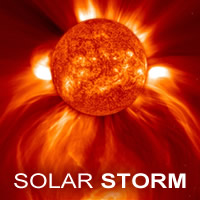
Solar storms emit energy in the form of electromagnetic radiation that interfere with the Earth’s magnetic field. A once-a-century super solar storm is expected in 2012 and threatens to knock out major technological infrastructure, including electricity grids, radio communications and navigation satellites.
What is a Solar Storm
The Sun is a rotating fiery ball of electrically charged fluid that generates magnetic fields as a result of constant churning activity. The complex tangles of high-intensity magnetic fields create violent eruptions of gases and plasma. The eruption is known as a solar flare or solar storm, and when exceptionally powerful, it can cause coronal mass ejections (CME).
Each solar storm is an electromagnetic bubble containing around a billion tonnes of material traveling at speeds up to 5 million miles an hour. The more tangled the Sun’s magnetic field, the more frequent these eruptions become, with the number of outbursts reaching a maximum every eleven years. The last solar maximum was in 2001.
Solar storms emit energy in the form of electromagnetic radiation, including X-rays, ultraviolet radiation, visible light, and radio waves. They may last a few minutes to as long as an hour.
Northern Lights
The aurora (the northern and southern lights) is the manifestation of solar storms, and is created when hot solar particles enter the Earth’s protective magnetic bubble and energize the atmosphere high above the north and south poles.
When is the next super storm expected?
Astronomers have noted that since the 1940s, and particularly since 2003, the Sun has become remarkably turbulent, and predicts a peak around 2012. This peak is forecasted to create storms of unprecedented intensity since the 1859 “Carrington event”. A perfect storm is created once per century.
Damage from Past Solar Storms
On the 1st of September 1859, the most powerful solar storm in history was recorded. The Sun ejected a huge mass of high-energy protons from a solar flare that traveled directly toward the Earth, disrupting telegraph systems all over Europe and North America. Fires erupted in telegraph stations due to power surges in the wires; and the northern lights were seen as far south as Florida.
In March of 1989, another severe solar storm melted the transformers of the HydroQuebec Power Grid, causing a nine-hour blackout that affected millions of people in Canada.
In 2003, a solar storm disrupted satellites and global communications, air travel, navigation systems, and power grids all over the world. It also affected systems on the International Space Station.
The Likely Effect on Aviation
Today, because of our high dependence of electricity and electronic systems, we are more vulnerable to the effects of solar storms. It is likely to knock-out virtually every major technological infrastructure on the planet, including electricity grids, radio communications, navigation satellites and other wireless networks, essentially crippling the air transportation system. Damage would be in the trillions of dollars and recovery time would take years.
What is being done to prepare
NASA’s STEREO spacecraft mission has been launched to view the Sun from positions either side of the Earth. These spacecraft have made the first 3D images of the Sun, allowing complex changes in the Sun’s magnetic field to be studied in great detail prior to the eruption of a solar storm.
The STEREO spacecraft also carries cameras that image the space between the Sun and the Earth so that Earth-bound storms can be tracked. If a storm is detected early, satellites can be made to hibernate and electricity companies can prepare for power surges.
How can you help
The Royal Observatory, Greenwich and the Galaxy Zoo teamed up to create “solar stormwatch” where members of the public can signup and assist by identifying and tracking storms using the STEREO images.









5 Responses
Hi Wayne, Solar activity is a subject that I studied in great detail about 4 years ago and I have some theories about the magnetic interactions that occur in our solar system. The truth of the matter is that Solar storms happen constantly but it’s only the ones that come in the direction of Earth that we have been able to study. I find that one of the most intriguing aspects of the sun is the differential rotation that scientist have yet to explain. I’d love to talk more about this with you soon. Thanks.
Thanks for the offer Ileane, I’d love to keep this conversation alive as we learn more about the sun’s behavior. This is pretty new stuff to me, but we’ve all got to keep this subject at the forefront given the impending massive storm in 2012-13.
Wayne, the solar stormwatch sounds like what the SETI project does. As a screensaver, the user would download the information from the SETI project, and while your screensaver was running, your computer would be running through the waves collected by SETI to look for life.
I also wonder if what the Mayan predicted about 2012 is the massive solar storm. They were amazingly correct on studying the heavens.
I didn’t know solar storms could last up to an hour! I assumed they only lasted for several minutes similar to an earth quake.
I see this as a large scale temporal causality loop. It will produce unintended consequences – as virtuous cycles produce unintended benefits and vicious cycles produce unintended harms. I will fly in a plane deliberately, on Monday 8 Aug 2011, all day at 30,000 feet above sea level. I will report my findings if I survive on y.t. BGalagaeman